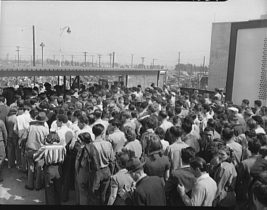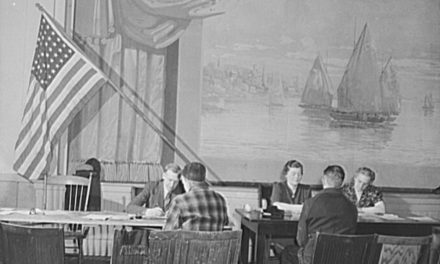As strikes across the U.S. slow down the economy, President Roosevelt has chosen to intervene: four times he has ordered the Army or Navy to take over striking factories.
In the six months between December of 1941 and June of 1942, there were 1,200 recorded strikes, 270,000 strikers, and 2.3 million work days lost. Looking at war industries only, the numbers decrease slightly, with 581 strikes, 250,000 strikers and 1 million work days lost. Despite the current agreement negotiated by the War Labor Board (WLB) for major industrial unions to halt strikes in favor of contributing to the war effort, employees are finding it difficult to stick to their word.
In St. Louis, 3,000 truck drivers decided to strike, putting a halt on the delivery of important war materials to defense factories. This action immediately dropped the war plants’ productivity by 30 percent. In a desperate effort to restore the plants’ previous efficiency, secretary treasurer William Maul of the Teamsters and Chauffeurs Union has begun negotiations with the drivers to persuade them to return to work. Maul’s suggestion of doubling the truckers’ pay from $3 a week to $6 may be just the motivation the drivers need to get back in their trucks.
A factory takeover was recently put in the works when a group of Army officers seized control of the S.A. Woods Co. munitions plant in Boston after the workers’ strike—once again ordered from President Roosevelt because of the strikers’ violation of the War Labor Board ruling. The officers arrived at the plant at 8 p.m. on the night of August 19; they patrolled the grounds heavily armed. The transition of power went smoothly. One could hypothesize that the reason for this is largely based on the government’s practice—Boston and Detroit’s plants were not the only to be controlled by the military. The Navy commandeered the Bayonne, NJ, General Cable plant only last week after the workers refused to accept the WLB agreement.
“The only cure [for strikes],” says the Detroit News, the largest newspaper in the city, “is solemn realization on the part of every citizen of the truth of the sentence, ‘Detroit can either blow up Hitler or it can blow up the U.S.’ Which it does can be determined only by Detroiters.”
Yet Mayor Edward J. Jeffries of Detroit argues, despite the factory seizure, “I’ll match Detroit’s patriotism against any other city’s in the country.”

Factory workers leaving after a shift at a defense plant. If workers like these go on strike, US war production will decline. Photograph by David Bransby (Library of Congress).
Despite the ongoing strikes, U.S. citizens are determined to help their brothers and sisters fighting overseas. For every factory worker on strike, two more are working hard to help the war effort. Mrs. Sophus Keith Winther works eight hours a day on an assembly line, not disheartened by the Allies’ current position in the war, but motivated to work even harder.
As long as the war continues, there will always be those workers who continue as well.
“It’s noisy and it’s a dirty job,” says a 19-year-old female factory worker from Buffalo, New York, “but it’s my big chance to help.”
Yet the problem of strikes is not going away anytime soon. Eleven aluminum plants are already on strike, and aluminum employees represented by the Congress of Industrial Organizations (C.I.O) are considering a strike as well. The government has not decided whether to send troops, but with aluminum playing such an important role in war production, these are strikes the U.S. cannot afford.
Sources:
Army Takes Over Boston War Plant. (1942, August 20). The Washington Post, p. 29.
Hitler or the U. S.? . (1942, August 24). TIME, 40(8), 19.
STRIKES IN 2 CITIES HIT WAR PLANTS. (1942, July 22). New York Times, p. 27.
The Workers . (1942, August 24). TIME, 40(8), 18.
Wolman, L. (1942, August 16). Wartime Strikes. The Washington Post, p. B2.





